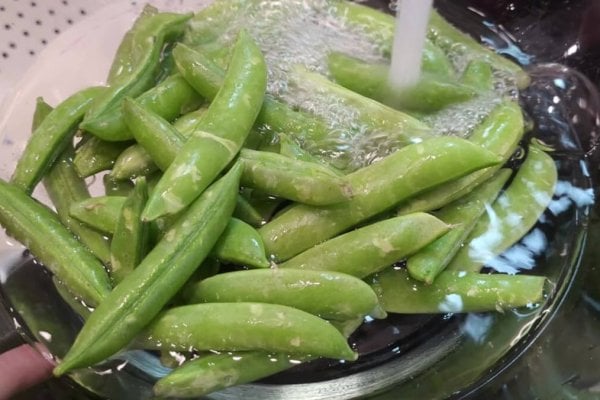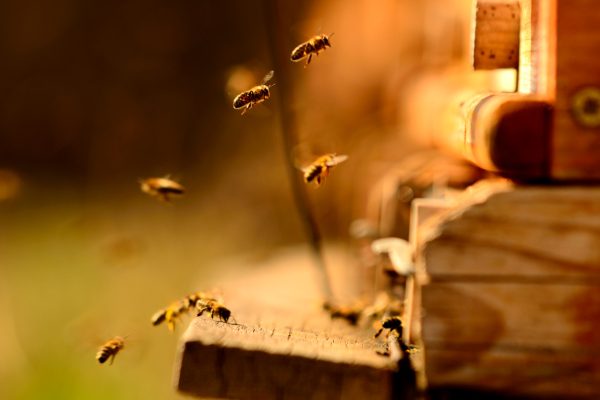

Growing a year’s worth of food doesn’t have to be intimidating. In fact, Melissa K Norris from Pioneering Today is sharing how to successfully grow a year’s worth of food without getting overwhelmed in this week’s episode of the Pantry Chat.
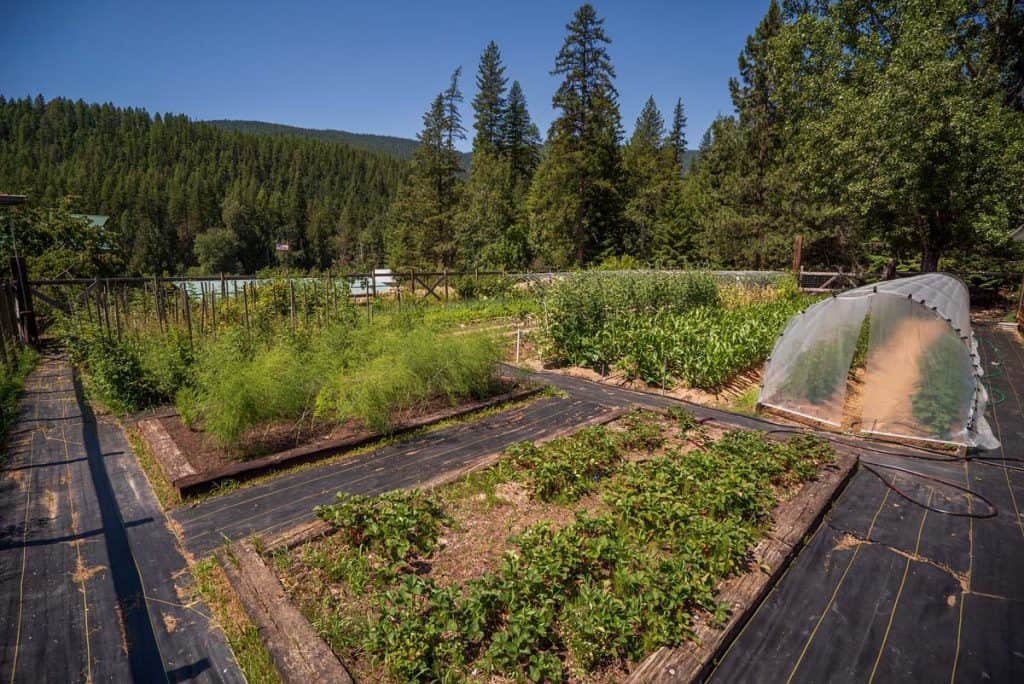
We’ve heard from so many people who started gardening a couple of years ago that they’re ready to take their gardening skills to the next level. Instead of growing a bit of this and a bit of that, they’re ready to look deeper at what their family eats in a year and start eliminating products being purchased from the grocery store. But how do we avoid garden overwhelm?
In order to do this, you have to know how much of a specific crop you need to grow and how you’ll preserve and use it throughout the year.
This next level of gardening can seem intimidating, which is why I’m glad to have Melissa K Norris on the Pantry Chat as she’s been growing a year’s worth of her own food for over a decade (in fact, she learned from her own parents as a young girl).

In fact, when Melissa first wanted to grow a year’s worth of food, she created charts and graphs and everything she needed in order to grow her crops successfully. She then turned all the information she learned while doing it herself into a book called The Family Garden Plan.
Inside The Family Garden Plan, you’ll find all the information needed on the basics of gardening (including soil health, crop rotation, sowing/planting dates, etc.), but it also includes charts for you to fill out to calculate how much food you need to grow for your family.
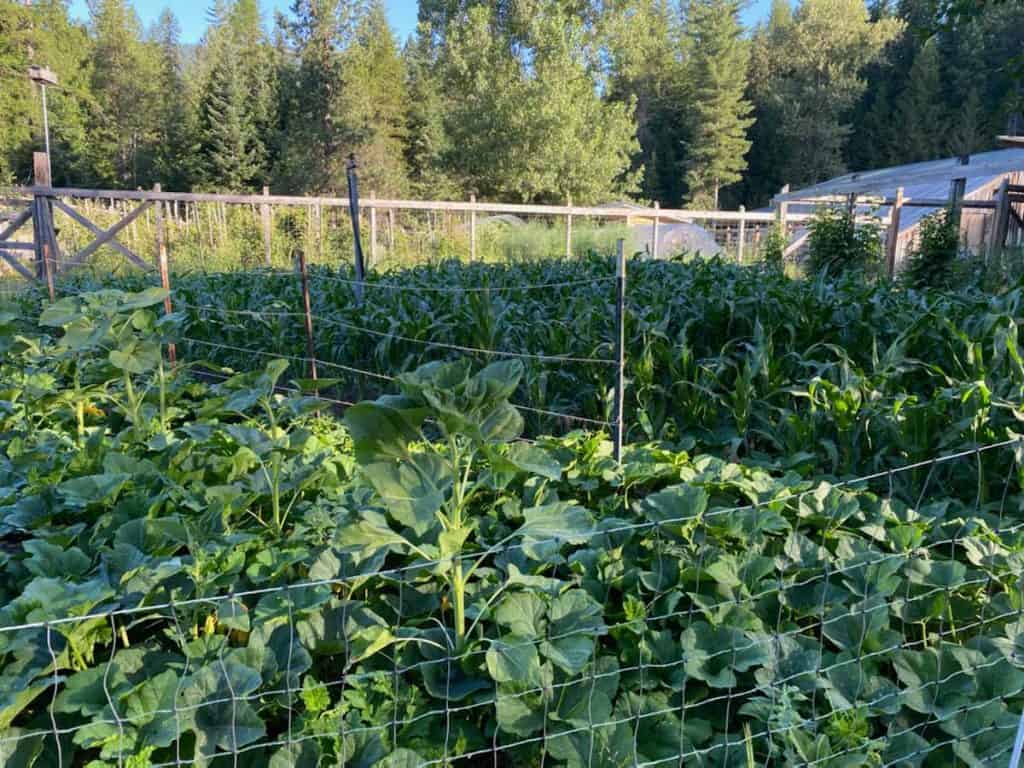
Why We Love This Growing Method
We love the idea of growing enough of one crop for a year’s worth of food for your family for many reasons.
- Saves money
- Healthier
- Skill Sets
Saves Money
If you pick a food item that your family eats a lot of throughout the year, this can really impact your grocery budget. For example, Melissa’s family eats a lot of tomato products throughout the year.
They use canned tomatoes for soups and stews or to be turned into fresh salsa. They use canned tomato sauce for spaghetti and pizza sauce. They’ll eat fresh tomatoes all throughout the summer months, and if you pick enough green tomatoes you can allow them to ripen in a cool location for fresh tomatoes well into the fall and sometimes winter months.
A pack of tomato seeds that costs a few dollars and can produce enough tomato products to feed your family for a year adds up to huge savings!
Healthier
The closer you can get to eating produce straight off the vine the healthier that food will be. If you think about the distance food has to travel to get to your plate, you want to reduce that distance as much as possible.
When growing food in your own yard, you harvest and preserve that food within a matter of minutes or hours from that crop being on the vine, so the actual nutritional value of that food is also higher than buying it from the grocery store.
Skill Sets
Learning to layer in growing methods one step at a time develops a skill set that you may not pick up if you try to do too much all at once.
Growing enough of a single crop to put up for an entire year builds your gardening skills as well as your preservation skills.
In an age where the supply chain continues to be upset, it’s high time we relearn the basic skill sets our great-great-grandparents knew and practiced.
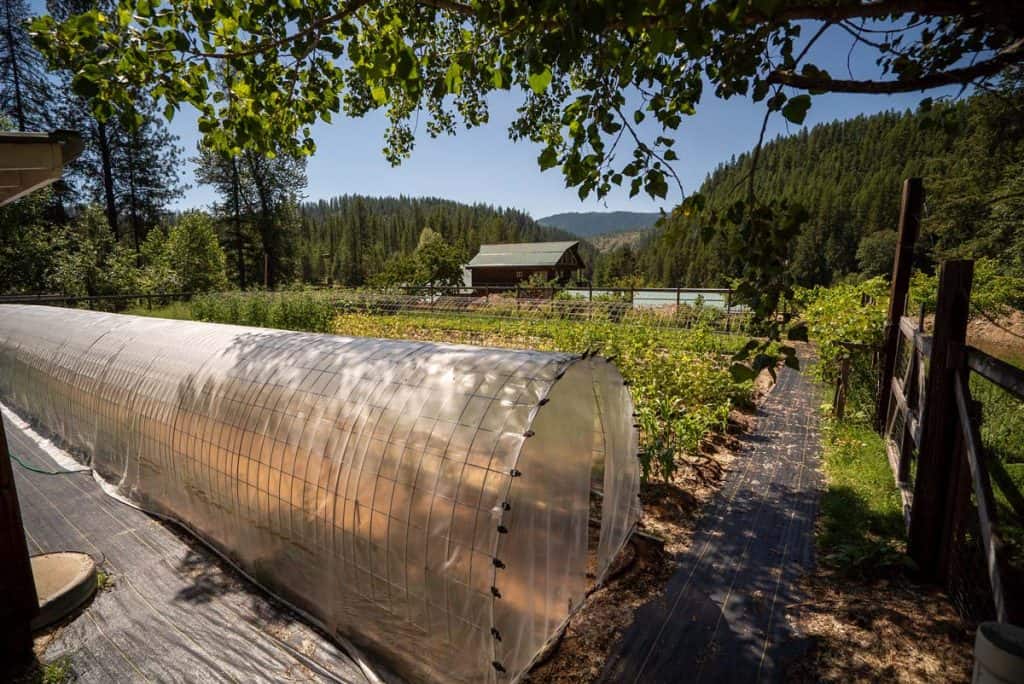
How to Grow a Year’s Worth of Food
- Pick a crop
- Assess your climate
- What does your family eat on a consistent basis?
- Consider Your Space
- Grow Crops that Produce More
- Grow What You Know How to Preserve
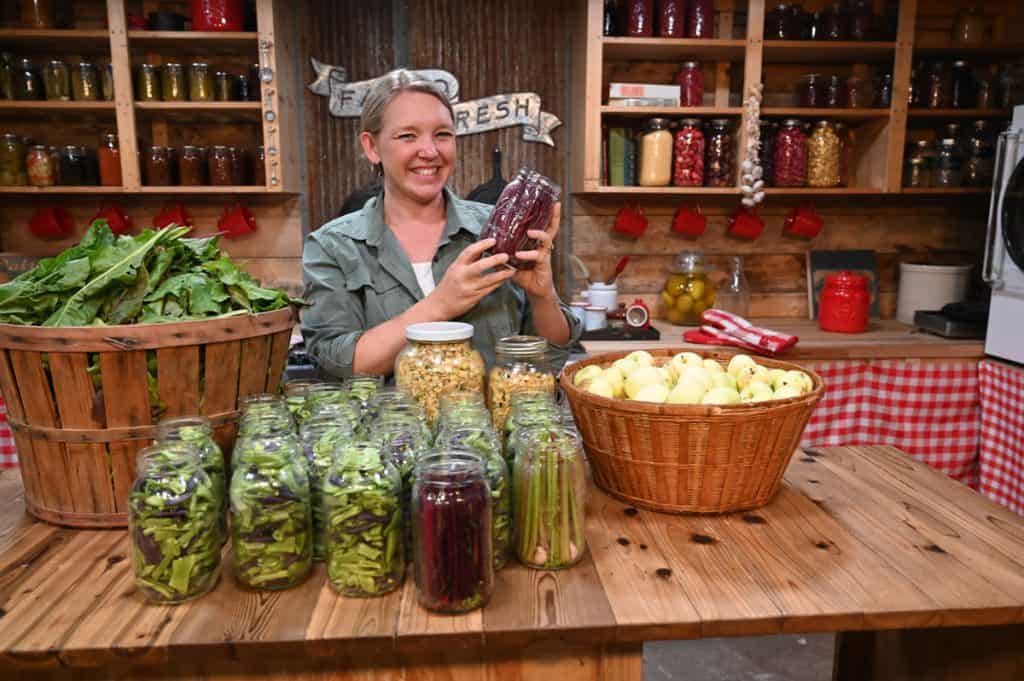
Pick a Crop
The best place to start when beginning to grow a year’s worth of food is to pick one crop and focus on planting enough of that crop to feed your family for a year.
This doesn’t mean you’re not also growing other crops, you’re just not growing an abundance of those other crops all at once.
Once you’ve successfully grown enough of that one crop to feed your family for a year, the following year you can layer on a second crop. After a handful of gardening years, you’ll be amazed at how much food you’re growing and preserving for your family!
Assess Your Climate
Do yourself a very large favor and pick a crop that you know grows well in your climate. If you live in the far north (like we do in Idaho), don’t try to grow enough sweet potatoes to last you a year! Sweet potatoes don’t grow well in our short growing season, so we would choose something else that does really well, such as beans.

What Does Your Family Eat?
Before growing a year’s worth of a specific crop, assess what your family already eats on a consistent basis. You don’t want to grow a year’s worth of canned green beans when your family doesn’t like eating green beans.
When trying to calculate how much food your family eats in a year it takes a bit of thought. Melissa has taken all the guesswork out of it by creating charts and directions on how to do this for your own family.
The first step is to figure out how much of a specific food item your family eats during an average week. Multiply that out by 52, then calculate how much of each crop you need to grow to preserve that amount of food. This will be based on the average yield each of those plants produces.
None of this is rocket science, however, if you want the legwork already done for you, then we highly recommend getting Melissa’s book The Family Garden Plan.
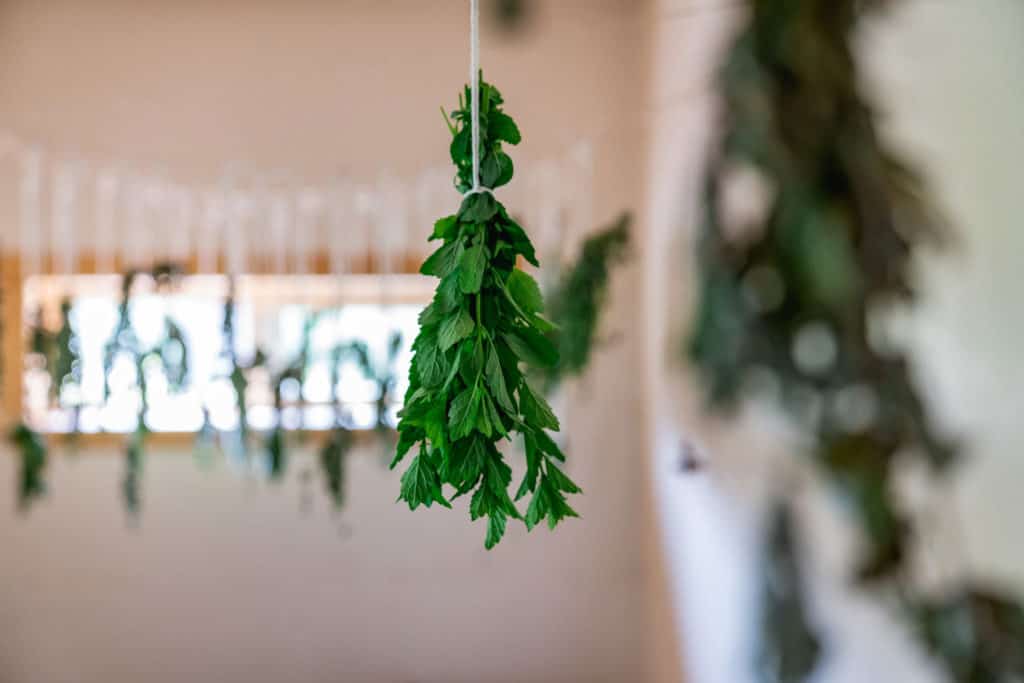
Consider Your Space
Often when people think about growing a year’s worth of a crop they immediately discount it because they think it will take up more space than they have available.
However, if you think about how much space the crop will take up, you can adjust to find something that will work with the space you have available.
Even those living in an apartment can grow enough herbs (basil, dill, oregano, etc.) on a sunny balcony or windowsill to preserve and have enough for a year.
Furthermore, you don’t need any special equipment to preserve herbs for a year. You can preserve herbs in salt, and you can dry herbs by hanging them, using the oven, or a dehydrator.
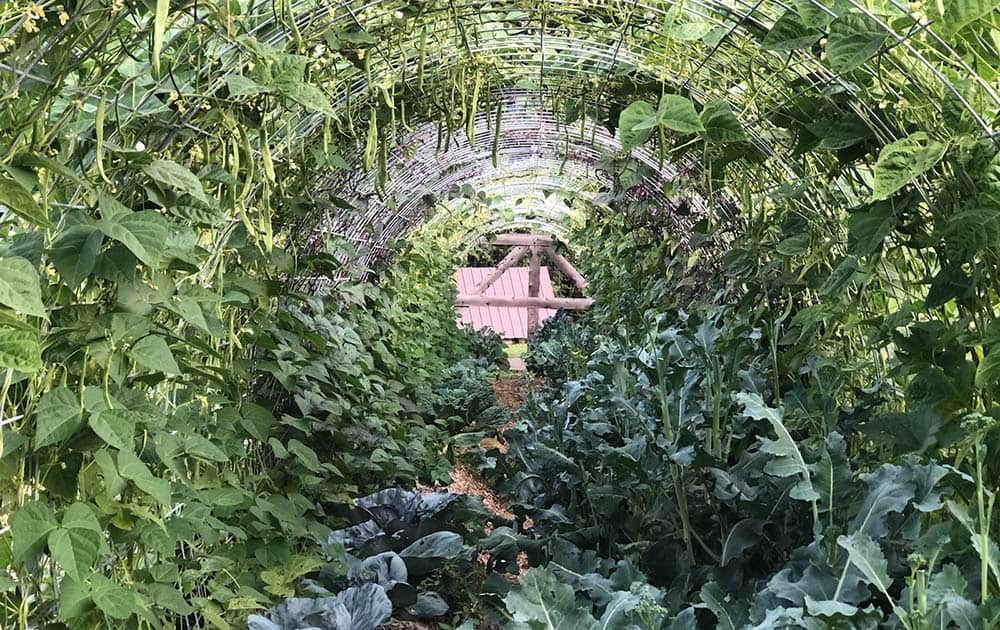
Grow Crops that Produce More
When thinking about the items you want to grow, consider how much return you’ll get from a single plant. For instance, if you plant one clove of garlic, you’ll harvest one head.
However, if you plant one bean seed, you’re going to get a ton of beans (especially if you grow pole beans as they produce more than bush beans).
If you plant a single tomato plant, you’ll harvest a lot of tomatoes from that one seed.
But for every beet, you have to take up space in the garden for every single beet. Same with onions, leeks, etc.
Items that can grow vertically such as beans, peas, even cucumbers can be grown in a very small amount of space, whereas a squash plant grows out and needs quite a bit of area to grow.
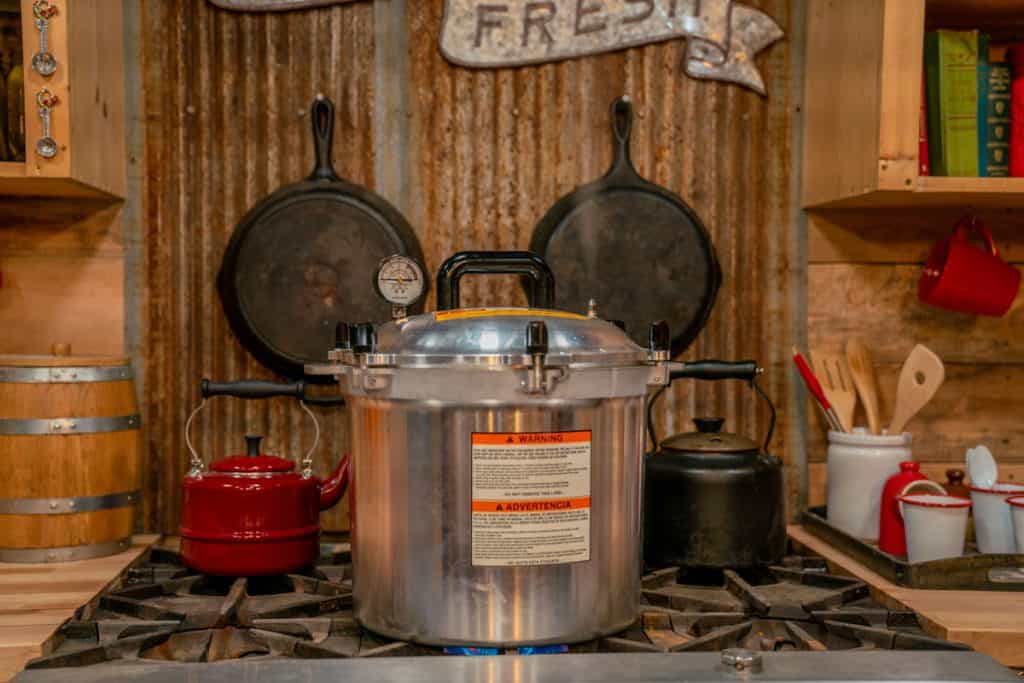
Grow What You Can Preserve
If you don’t have a pressure canner, don’t plant a crop that must be pressure canned in order to safely preserve it. And on that same line of thought, don’t grow a year’s worth of pumpkins if you don’t eat them on a regular basis.
Trust me when I say that you’ll grow enough squash for a year, but those squash will end up going bad because you’re not already in the habit of eating them. (If you do like pumpkin, try pressure canning pumpkin the easy way.)
So grow what you know you’ll eat and what you can preserve!
Your garden needs to be practical, and even more so as homesteaders because our garden is just the first step into everything else we’ll be doing (preserving, seed saving, etc.). But whatever way you get started it needs to be doable and using Melissa’s book can be extremely helpful.
Don’t over complicate your garden! Just start somewhere, and when you’re ready to move to the next step, layer in this method of growing a year of one crop at a time.
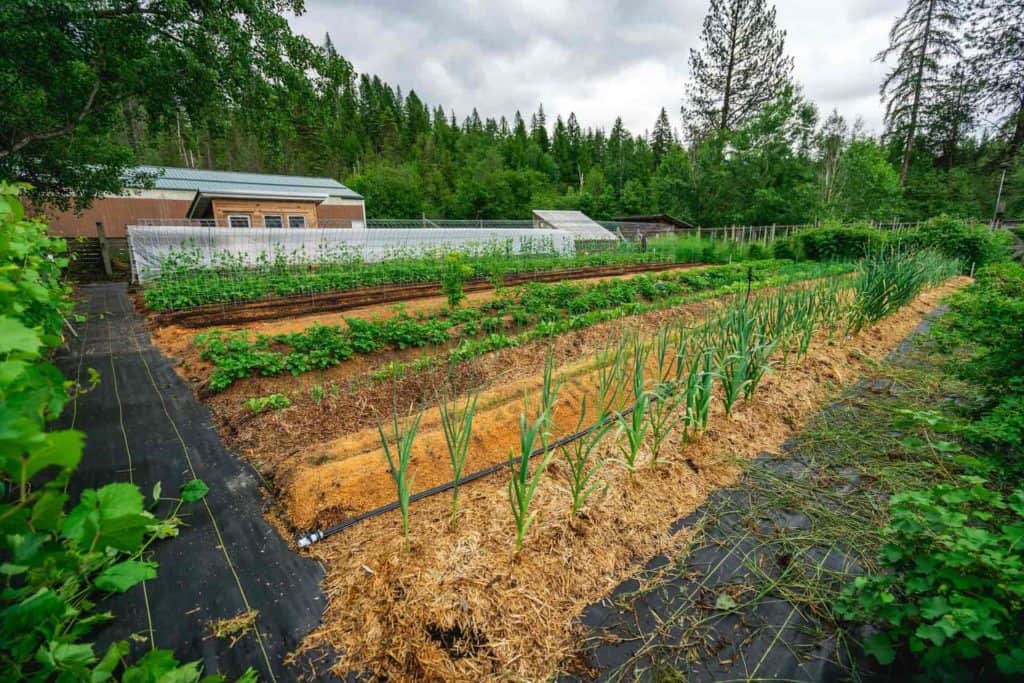
Other Posts You May Enjoy
- Traditional Skills Summit
- Choosing the BEST Vegetable Seeds for Your Garden
- The Benefits of Container Gardening
- 3 Things You Must Do To Increase Self-Sufficiency
- How to Raise a Year’s Worth of Meat
- Does Homesteading Save Money on Food
- Growing Onions From Seed with Mellissa K. Norris
- Are Quality Garden Tools Worth the Cost? with Will from Homestead Iron
- Best Way to Use Up Garden Produce – Garden Stir Fry
- Building Resilience with Justin Rhodes
- Health Benefits of Going Off-Grid (Off Grid with Doug and Stacy)
- Raising Goats 101: For Dairy with Anne of All Trades
Carolyn: Hey, you guys, this is Carolyn with Homesteading Family, and this week on The Pantry Chat we have a special guest in house. Actually, I'm in her house. So welcome to Melissa Norris from melissaknorris.com. I'm so excited to have her here.
Today we are going to be talking about stepping up your gardening so that you're actually growing a year's worth of a crop. So I'm really excited about this because there are a lot of people out there who are like, "Okay, I'm ready to go from salad gardening or maybe hobby gardening to getting serious about putting food on the pantry shelf."
Melissa: Yes.
Carolyn: This is a good year to do that.
Melissa: It is an excellent year to do so.
Carolyn: If you have not done this yet, be serious about this and really let's listen to what Melissa has to say. She's definitely an expert on this. So I'm excited to have you here. Thank you.
Melissa: Me too. I'm very excited to have you here on the homestead. That's so special for me.
Carolyn: Yeah. I guess, yes, I'm here with you. Many of you guys know, Melissa and I are actually best friends in real life, but as odd as it sounds, we don't actually have the opportunity to hang out in person very much and this is my first time here at your place. So it's been a lot of fun. We've been having a good time.
Melissa: It has been, yes. We've probably had too much fun if that's possible.
Carolyn: Yeah, we really enjoyed it. Josh is here too. He's floating around somewhere. But you know that secret project we keep hinting at? Well, let's just say Melissa's involved and we've been working on it and it's really exciting. It's fun to see it start coming together and see pieces coming. So I know we're going to tell you about it one of these days, but it is exciting. We actually had a lot of people guessing that it was that we were going to be involved in Abundance Plus, which is great, and we are going to be involved in Abundance Plus, we have some stuff going on in the background for that, but that is not what this project is. I've got to tell you guys, it's actually a lot bigger than us being involved in Abundance Plus.
So it's really exciting. This is really exciting. This is actually going to do some amazing things in the homesteading world, so it's pretty big. It's a big thing.
Melissa: It is a big thing, and it's worth the wait.
Carolyn: Yeah. Okay. Well, we'll try not to be teasing. You guys will be the first to know about this for all of this teasing. We'll definitely let you know.
So, okay. We're going to dive right in. What have you been up to this week, aside from working on secret projects?
Melissa: Aside from secrets projects? Well, the week prior, or I think it was only two days prior, I was working on, it's not a secret, but I've just started being able to share about it, I actually was doing a three-day photo shoot. Let me tell you what. You know how you clean and get things prepped before hosting Christmas dinner or Christmas Eve? Well, when you have people coming to your home and you're filming and doing photo shoots that are going to be broadcast to the public, there is nothing that lights a fire under you and gets you to [inaudible 00:03:19]. Not that I'm slovenly to begin with, but it was a whole new level of motivation.
Carolyn: So you just did your whole spring cleaning in like three days?
Melissa: I did. Yeah. In three days. But we were working on, which I do actually get to talk about, so you guys can hear this one, I'm very excited about it, a preservation book that we'll be releasing the end of this summer. So it was really fun pulling out all of my stuff, but I'm really excited because, one, it was great for me because this is springtime and I'm doing a lot of my seed starting getting ready to finalize exactly what's going in, how much do we need of every single thing. Four years worth of different foods. So it really gave me a good scope of, okay, I'm flush this, I still have a lot of this preserved, I'm almost out of this, I want to do more of this. So it actually was perfect timing for me planning-wise for the garden.
But then I'm so excited because it's a preservation book that's covering all of the waste freezer food at home, which is really what a homestead needs. I mean, we all love canning, dehydrating, fermenting, root-cellaring, and even using the freezer, but to have it all laid out in one resource. It was kind of like I want to be able to go somewhere when I've got 20 pounds of asparagus that I need to deal with and strawberries are coming on, because those are a little bit earlier in the year, I just need a resource where I can go and can I look at asparagus and it tells me all of the safe ways that it can be preserved at home and then it gives me the recipes and the tutorials that I need in one spot.
I don't have time to hunt and peck and search all over Google and wonder is this actually from an approved source or is this a trusted, is it going to turn out? I'm like, I just wanted it all. I'm like, "Okay, well if I'm going to create this document for myself, I probably should share it with other people."
We don't even have a title yet, but I'm super excited.
Carolyn: I'm excited about it because I think you really nailed it is that you end up with these huge baskets of tomatoes on your shelf and you're like, "Well, yeah, of course I can do diced or I can do whatever it is that we normally do, but sometimes you just want it right there, you don't want to have to go dig through the books to what is that processing time and what exactly is this and what is that? To have it all in one place is I'm excited about that. I think it's going to be really fun.
So when does that come out? Right now, what's the target date for that book to release?
Melissa: Yeah, we're hoping the end of summer. I mean, with print time, and at the time of this recording there was even paper shortages, so we're in flux on getting the exact. I don't actually even have that yet because we're seeing can they get paper to meet the print times? All of that kind of stuff. Welcome to the rest... We're all in the same boat, experiencing that in all different ways. So hopefully by the end of summer. If we can get it sooner, we absolutely will, but it's coming this year. You'll still get to use it for harvest season.
Carolyn: Yay. That's exciting. So I'm sure we'll be talking about that more when it gets closer to the time.
So that was a busy week. On top of that, now you're talking about the photo shoot, but I'm looking around and I see you're starting seeds, you're doing all sorts of other things in the middle of all of that too.
Melissa: Yes. Yeah, because the garden, when you are seed starting, you've got a little window. I mean you can kind of push it maybe a week or two later, but much beyond that and you've kind of lost it and you might as well either just go buy them as starts. You've lost that opportunity. Yeah.
Carolyn: Yeah. You only have so long, especially if you're in a area with a shorter growing window.
Melissa: A shorter [inaudible 00:06:52].
Carolyn: Yeah. That's how we are is like if you miss that date to plant your bell peppers, then you might not get many bell peppers this year. So it's actually important to stick to that calendar.
Melissa: I've done it before, thinking, "Let's just see. I missed it, but I've got these seeds," and you get two and they're just starting to form, they're not even full yet, and then the frost comes and you're like, "That was really a waste of that space and my time." So, yeah.
Carolyn: Absolutely. Okay, so I have been canning. Actually, we're behind you quite a bit. You don't have any snow right now. You've got daffodils popping up. It's beautiful. It's so nice to see the sunshine. But at our house, we are starting to see a little bit of sunshine and the snow is melting, but we had such a heavy snow year that we still have snow sitting on the ground. So we are starting some of the long runway starts. We have our bell peppers seeded. We've got our celery in. We've got some of those things going, onions, obviously, inside, but we've really got probably a few more weeks before we start putting the rest of the things in.
So in the meantime, I am canning, canning, canning, and we just filmed a video for inside my membership, the Homestead Kitchen membership, a few minutes ago, and I was sharing that I have been really canning up a lot of meals. Because spring and summer get so busy and then you're right into fall, which is for us, the busiest season of all, trying to keep up with everything that needs to be done before winter hits on top of all the preserving. And you're still gardening. You still have to garden in the fall, even though you bring the stuff into the kitchen.
So I like having those meals on the shelf. So I've been really canning meals. I've been freeze drying meals. Let me tell you guys, if you have a freeze dryer and you have not made that chicken pot pie filling to go in the freeze dryer, go watch the video. We'll link it somewhere, wherever. Up here somewhere or down below. Go watch it because that stuff is phenomenal. I don't think it will last till fall. Everybody just keeps eating it. It's so good. It's like-
Melissa: I haven't done it. My freeze dryer, you guys can't see it, it's literally sitting right here, and I'm like, "I need to go watch the video."
Carolyn: Yeah. You need to watch the video.
Melissa: I need to do it. I haven't done that one yet.
Carolyn: Josh, I don't know if you heard him, but he says I make the best chicken pot pie in the whole world. So you need my recipe for that.
Melissa: I believe he said that's why he proposed.
Carolyn: [inaudible 00:09:35].
Melissa: There was a conversation, though.
Carolyn: It was, yes. It was one of the foods that I definitely used to keep his interest. There were about three main foods that I was like, I just keep like dribbling these out here and there as we were dating, and I it's a good thing. One day I'm going to write a book that's like Food to Catch a Man.
Melissa: Okay.
Carolyn: But that's probably not considered cool in the modern whatever world, but I kind of don't count myself as part of that world.
Melissa: I'm not one of the cool kids in the modern society either, so it's why we're good friends.
Carolyn: I'm sorry. I'm going to say it's a biological fact that men are attracted to good food. Okay? It's a good thing to cook for them.
Melissa: Yes. Okay.
Carolyn: All right, so before we get ourselves in too much trouble-
Melissa: Before we... Yeah, we're going to be in hot water in a minute.
Carolyn: Right. Absolutely. Okay, so we have a question of the day before we dive into the main topic. For those of you guys who are new to The Pantry Chat, we always do a little bit of chit-chat at the beginning, but we have it time stamped. If you're watching them on video, if you are listening in on a podcast, just fast forward and we do get to the main topic, I promise. But first, a question of the day. Whit McMole on Instagram: I have a bunch of seeds that are years old. Should I throw them out? I was thinking about throwing them all in one area and seeing what makes it.
I've got to tell you, I have absolutely done that same thing, just taken all my old seeds and tossed them into a garden bin. You'll be amazed what still comes up because some seeds are very resilient. Some seeds last a long time.
You do a lot more seed saving than I think we do, so for you, how do you store your seeds to last a really long time and then how long do you expect them to last? Or do you get fresh seed of everything?
This is an ongoing battle between Josh and I. I'm like, "They'll be good for five years. They'll be fine." And he wants fresh seed every year, which I'm kind of good with because I like having a lot of extra seed anyways.
Melissa: Right. Mm-hmm (affirmative).
Carolyn: But there has been the time or two where I've insisted that we don't buy the new seed and then we have had a bad germination [inaudible 00:11:54], and you know how that goes. You know?
Melissa: Yes. Every relationship ever, yes.
Carolyn: So the next year I'm buying all fresh seed. So what do you do?
Melissa: Yeah. It depends on the seed. So a rough rule of thumb is the larger the seed, so think bean seed and peas and squash, the larger seeds tend to be viable longer. So they will last. Now I will preface this with saying with the bean seed, because we have seed saved our own strain of bean seed in my family for over a hundred years, so I have not tried this with store bought, for lack of a better term, bean seed. But we have had bean seed that has been almost eight years old and it was like, oh, this is in the back.
Or I will have a year where, last year, for example, I had bean mosaic virus come through. It did not hit my October beans or my Cherokee black beans, it only hit my Tarheel pole green beans, which is our string. Which was actually devastating because it was the first year that my dad did not plant because he is 84 now and he... I'll cry if I talk about it. Anyways, of all the things that were hard and hit me, that was him aging.
Carolyn: Yeah.
Melissa: So anyways, sorry.
Carolyn: That's okay.
Melissa: So of all the years for it to happen, I can't go and replace those. I have one sister who grows them and a brother some years, but it's not like I can just go and order more of those seeds. So I was devastated, but thankfully a really close neighbor of ours also was growing some. It's so weird. He did not get hit with it at all. So it was very strange. Anyway, so I was very grateful and he's like, "I have got all the seed you want. Come and harvest everything that you want." So love having those good neighbors. So I was able to go and get that from him.
The whole moral of me sharing that story is there have been years where if you plant... Beans are self-pollinating, so they're a great thing to start with seed saving. However, if you have two different varieties of beans and you plant them close together, they will start to cross a little bit. You will begin to see that. So we had done that and then you don't notice till the next year's begins to grow. So you don't see it happening that year. So if you have got bean seed that's starting to take on characteristics of other beans, it actually happened the year before. So I had to go back and I had to start counting back this bean seed and what year I'd saved it to figure out where it had been crossed and then where I had a pure strain.
So we actually went back and we have grown bean seed that was eight years old. I did not have 100% germination rate, but we had well over 50% germination rate.
Carolyn: There you go.
Melissa: So littler seeds, especially, I have found the more oily littler seeds, like some of the lettuces and little tiny onion seeds, which are also tiny, those ones, about two years, and then I really start to see their germination rates go down. And of course storing them where it's dark, it's cool, it's not humid, and also with your seed saving yourself, which I know a lot of folks are hoping to get into, making sure that you allowed it to get overripe and fully developed on the vine before you bring it in and harvest it.
A lot of times with seed saving people, because there's the prime where you pick it where you're going to eat it, with seed saving, you usually let it go a little bit beyond that. So just that. So I've also found with seed saving if people don't do that, then they don't have quite as good a germination rate. But we definitely do.
But if you're questioning like, oh man, I'm not sure, you can do a little germination seed test where you get them damp, put them in a paper towel in a little Ziploc bag and then see how many of them begin to sprout, and that'll give you an idea if any of them are going to sprout or not, or if only half of them do, if you've got enough seed to plant what you want for the year for that.
Carolyn: Yeah. That's really the ideal way to go is just do your own germination test in your kitchen. That's fine, once they sprout, you can toss them out, you don't have to plant them. But if you only have 50% of them sprout, then you know you have to double seed them right?
Melissa: Yeah.
Carolyn: Just heavily seed them. And you can go a lot longer than that. You have your ideal window and you have your-
Melissa: The real life. Yes.
Carolyn: ... the germination rate isn't great, but I can just seed it really heavily window.
Melissa: Yeah. Yeah.
Carolyn: Sometimes you can get a really, really long time. If you're really interested in extending your seed life, whether you're bringing it in store bought or you're saving it yourself, Carol Deppe, in her book, I think it's The Resilient Gardener, has an entire phenomenal section on survival seeds and how to turn your seeds into a survival seed bank with additional dehydration time and a certain type of storage that should at least double your seed life at hydrogenation rates. So that's something to read and get into if you're interested in that.
But great. I think that's a great little discussion. If all else fails and you already have fresh seed and you're ready just to move it on, just throw it out into a bed and see what happens. It's kind of fun. Put it in an area that's not doing much anyways and maybe you'll end up turning it into a productive area.
Melissa: Yeah. Yeah.
Carolyn: Yeah, I like it.
Melissa: Just scattering some seeds, there's no loss. Try it.
Carolyn: There really isn't.
Melissa: Yeah. Yeah.
Carolyn: If you're just going to throw them away anyways, do that.
Melissa: Yeah.
Carolyn: Okay. So we're going to jump into the main topic today, which Melissa is very much the expert in and I really love this idea, and that is to start growing a year's worth of one type of food. So even some of us are starting a garden, some of us are starting to expand the garden. We're like, "Oh, how are we going to grow a year's worth of food for everything that we're trying to grow and get it into the pantry?" That may not be the right place to start.
Melissa: I would not start there.
Carolyn: Yeah.
Melissa: No.
Carolyn: Yeah.
Melissa: Yeah.
Carolyn: You could easily get overwhelmed and frustrated and then end up with a full failure and a lot of frustration, wasted money, and time and energy. So instead though, what's a great way to go?
Melissa: Yeah. Instead, I recommend that you pick one crop. This is going to be different for everybody for two reasons. One, if you've already been gardening and growing some of your own food, you may already be growing a year's worth of something. You might be growing a year's worth of a few things. I know you guys are. So my ideal for everyone, and this is even the challenge to myself so that I don't get overwhelmed but each year we're becoming even more self-sufficient, is each year I pick one more crop to grow an entire year's worth of. So that way you're building every single year, you're building that skillset, you're building up your pantry, but you're doing so in a way that's very sustainable. Because there is so much that goes on with homesteading, you have to pace yourself that way so that it's lifelong.
Carolyn: Yeah. That's the number one thing that we see is that people jump in maybe a little too wholeheartedly because it's easy to handle the seeds when they're in these little trays in your kitchen, like they're not a lot of work, but once they go out into the garden and they're in the wild and you're pulling out real weeds and not the little teeny things that pop up in your seed tray, it's a lot of work and it can be overwhelming.
Melissa: It is.
Carolyn: And then you have to get that thing into the kitchen and figure out how to preserve it all and everything.
Melissa: Yeah, and the space and getting confident with different methods. Yeah, so that. Then I also like to look at it from, one, you have to assess your climate, but secondly, looking at what is it that your family enjoys eating, likes to eat, and you eat on a very consistent basis. I mean, we love fresh strawberries, but I don't eat fresh strawberries all year long. Like when they're in season, I love them. However, cooking wise, we eat a lot of green beans and we eat a lot of tomato-based products. So tomato sauce, tomato soups, salsa, but the base of that is to tomatoes. Because I can create so many meals from a base of tomato or stretch it if we're doing tacos or nachos or something like that I'm going to be using the salsa, that type of a thing.
So look at what you are eating on a very consistent basis that will also grow in your climate. I happen to love sweet potatoes. We can't grow sweet potatoes here. Our season is much too short. So with those, go through, and the reason for that is because, one, if you have identified what that is and it grows in your climate, if you're producing that at home it's going to make a big impact on your budget. You're going to save a lot of money because that's something you're no longer buying at the store.
But it's also going to make a really big impact on your health, because when we're growing it at home, we are harvesting it right at peak, we're taking it right off the vine, and then we're preserving it really close to that. So there's not that space of it being picked and then it being shipped because as soon as food comes off of the vine or off of the plant, it's picked, it does begin to lose its nutrients. So the faster that you can preserve that or consume it, you're going to have a higher nutrient load than anything that you buy off the store. And sometimes even the farmer's markets because you're picking it in your backyard, you're bringing it in and dealing with it, and even the farmer's markets, they're going to pick it the day of, maybe the morning, but most of them a few days before.
It's still a much fresher option than probably most of the things on your grocery store shelf produce wise. I'm not dissing farmers' markets. But if you can figure out how to grow that yourself, you're making so many impacts on your health and your budget and you're doing it one item at a time.
When you're looking at space, I think people think a year's worth of food and they're like, "I don't have the space for that." Well, think about everybody has space. Even if you live in an apartment, you could grow a year's worth of herbs most likely. Pick basil. Pick something like dill. Something that grows and is leafy and you're harvesting the leaves. Oregano. So really, if you don't have space yet, or you're like, "I don't really have time to do a full on garden or I just have a balcony", pick an herb and grow and harvest a year's worth of that.
Plus you don't need any special equipment in order to preserve herb. You can do them in salt. We have a herb salt video, you guys can go and check that out, where we used a couple different methods, but it's using salt and it preserves it for the whole year. You can dry them without any special equipment. You may even be able to grow basil all year long if you have a sunny window sill indoors even.
So think about starting small. If you've got a little bit more gardening space, think about vertical and things that produce multiple per plant. So what I mean by that is if you plant a garlic clove, you're going to get one bub of garlic, but that's it. It's a wonderful thing. We do grow year's worth of garlic. But if you plant one bean seed, you are going to get a ton of beans, especially if you do a pole bean. Pole beans produce more per plant than bush beans. You do a have to provide some type of support, but then you can also usually grow underneath them. I'm a huge proponent of pole beans if you can't tell because I can put two crops in the same space and I'm getting more beans. So I love them.
But think about that. Like tomatoes, you get multiple tomatoes per plant. You get one onion per onion set. So think about that. We're not saying don't plant those. Like root crops, you do get a lot of potatoes per plant versus one beet per plant. So kind of think about that. That'll help you maximize your space if you're really going for a year's worth of something. It's easier to grow in a smaller amount of space a year's worth of green pole beans than it is a year's worth of beets, for example.
Carolyn: Yeah. I think that's so valuable. So I'm just going to sum up a few of the things that you just said here, because I think there's a lot packed into there and it's so important. So pick one item that your family likes to eat. This is so important. So many people are like, "Well, I'm going to grow a bunch of cabbage because I hear that it grows well in this area." But their family doesn't like to eat cabbage.
Melissa: Or you don't know how to cook it.
Carolyn: Well, yeah. [crosstalk 00:24:19] all the time.
Melissa: Yeah. It's not something that you're using on a regular basis and so you're not sure how to prepare it different ways.
Carolyn: Well, and that's even me. I still struggle with winter squash and getting that into the diet. Yeah, I can grow tons of it, but if you're not in a position to put it into your diet. I mean, I don't want to eat pie every week, pumpkin pie every week, you know? So you've got to figure out how to eat it in a savory way. So make sure it's something that you like to eat, you're already eating, and you know how to prepare. So I really like that.
Make sure it's a food that grows really well in your area. If you need any special modifications to your climate, it's probably not the right food. For us, that's tomatoes. Tomatoes don't like North Idaho unless you've got plastic hoops over them.
Melissa: That's how I have to grow them too.
Carolyn: Yeah. So it might not be the right place for you to start. Make sure that also choosing something that has a really good return for the space you're putting towards it. So lots of fruit on one plant, lots of produce on one plant, instead of just one. I think that's all super valuable.
Something I really like about this method is this idea of leveling up your gardening one crop at a time is it gives you time to learn about that crop.
Melissa: Yes.
Carolyn: Right?
Melissa: Yes.
Carolyn: It gives you time to really dive in. If you're just like, "Oh, I'm going to grow more of everything," you're trying to learn more about the problems that you're encountering, why it isn't growing, what the soil conditions are, and then you're figuring out how to preserve it in different ways. You're like, "Oh, okay, bell peppers have to be preserved this way and carrots are this way," and you're having to give your brain to a lot of different things. But instead you can have this deep dive year where you're like, "This is my potato year."
Melissa: Yeah.
Carolyn: You know? Whatever it is. And you're investing yourself into this one plant so by the time next year rolls around, you are already a potato pro and you're ready to go on and become a, I don't know, a tomato pro. Whatever it is that's next. So I really think that this helps to move you forward substantially while not being super overwhelming at the same time.
Melissa: Yeah. Yeah. So I like that. Yeah.
Carolyn: So did you have one thing that you started with in doing this?
Melissa: Yeah. Yeah. Actually, it was the green beans, and the reason for that is because growing up I always helped in the garden. I remember being a toddler and going behind my mom and she would show me the knuckle on your finger, how deep to poke my hole to put the seeds in for whichever it was and I remember the green beans vividly. So my mom always canned because we always seed-saved and we only ate our homegrown green beans. So I never had store-bought. So I grew up watching and knowing that so it was very natural for me when we, as a newly wed, my husband and I started our first garden, I already knew what it looked like to grow a year's worth of green beans and I knew how to preserve them.
But that was the only crop that we grew a year's worth of and preserved. So for years, we had fresh eating from the garden, of course, but the only thing I was growing a year's worth of and preserving was green beans. Then I had some health scares and started looking at the food I was buying from the store.
For example, tomatoes, because tomatoes are very hard to grow here in the north. Especially we get double the amount of rainfall that you guys get, and you guys already get a decent amount of rain. So only way that I can grow tomatoes here without experiencing blight, it has to be under cover. So my parents never dealt with tomato. We didn't grow tomatoes because they're kind of a pain, and like you were saying, that they take special care. But at that time, 12 years ago, in order for me to find in a glass jar heirloom truly organic tomatoes or tomatoes sauce that didn't have high fructose corn syrup in it or a ton of added sugar, all the things, the only way that I could find them and, one, we could actually afford it, honestly at that time, I had to figure out how to grow them.
So I knew if I knew if I could do it with beans, I could figure out how to do it with other items if I serious and intentional about it. So that's how I started and then it was that, then just each year I'm like, "Okay, I had my tomato year, got that figured." That one actually took me two years, I'll be honest. That took me two years to figure out. Then we just started adding in the rest and the rest and the rest.
But I know probably a lot of people, because I had the same thought, I'm like, "Well, I know what we need for green beans," because I had been doing it so long and I just mimicked the amount. I cook similar to my mom. I don't know, if you have a mom who cooked when you were a girl, you probably cook similar dishes and amounts just based upon the number of mouths you're feeding. You know? So I'm like, "How do I know how much is a year's worth of this stuff?"
Carolyn: Right.
Melissa: For my family's size, because what's a year's worth for me and what it's a year's worth for you guys is very different numbers.
Carolyn: Very different.
Melissa: Extremely different. And based upon what you eat and how often, it's going to be different numbers. So I sat down and created a worksheet for myself on how to figure out, and sometimes I feel guilty for saying this, when I grow up I want to be one of those cool people who menu plan, like have a whole month of all the meals done on the calendar.
Carolyn: Oh wow. That's ambitious.
Melissa: Right?
Carolyn: I feel really good if I get a week done.
Melissa: That's where I'm at. We're about a week. I know the meals for about a week and I've got those things I can pull out if I don't have anything. I'm like, "Oh, I know I can make that real quick."
Carolyn: Right.
Melissa: But I didn't really know in a month to be able to calculate times 12 how much are we actually eating of all of these individual things? So I had to create myself a worksheet. I created a sheet and I tracked it and then I could go and look at the average amount each vegetable and fruit would produce per plant in an average growing year. Then I'm like, "Okay, based upon these two things, now I know exactly how many I would need if I want to produce a year's worth of those foods."
Carolyn: Right.
Melissa: Which is actually all in this chart. Anything that I create, it's because I need it or I want it.
Carolyn: Yeah.
Melissa: So that was the basis for this, the family garden plan, but all of those charts and those worksheets and even more of them, they're all in here. Because your garden needs to be practical, and as a homesteader, I think even more so, because we have a more sustainability goal than just gardening. Our goal is to really feed our family and also beginning to seed-save.
Carolyn: Right.
Melissa: We go so far beyond. Homesteaders, the Lord bless our hearts because we are ambitious people.
Carolyn: We're not afraid of hard work, are we?
Melissa: No, we're not. No.
Carolyn: Maybe not as afraid as we should be sometimes.
Melissa: Sometimes this is true. Yes. Yeah.
Carolyn: Well I think that is amazing. I will definitely put the link to this book in the description for you guys. Because that is so valuable and a lot of it is based, any chart that you get in gardening, it's based off of somebody's garden.
Melissa: Yeah. Yeah.
Carolyn: It may not be perfectly accurate for your garden. Maybe you live in Georgia and you are in the far opposite side of the country than we're in, but it's still a starting place. That's what we all need. We need a starting place and then you need to start keeping your own records so that you can adjust as necessary.
Sometimes those records are as easy as, you were talking about this at the beginning, looking at the food that you still have on the shelf when it comes back to garden season and being like, "Whoa." For me this year, I don't know what I was thinking, but I put up quadruple the amount of pickles that we need. I like pickles, but that was a little control.
Melissa: You didn't need that many.
Carolyn: I did not need that many pickles. I'm going, "Well, I wonder how much the pigs like pickles right now?" Because after they sit on the shelf for about a year, they're not as crispy as they used to be.
Melissa: No.
Carolyn: Anyways. So it can be as simple as that. It doesn't need to be complicated. You don't need to do anything really advanced, but just taking a note that, hey, last year I put up this many jars and we're still going to be eating these next winter, I don't need as many, and just adjusting for there. I think that simplifies the whole thing, and again, especially if you're doing it one crop at a time.
Melissa: Yeah.
Carolyn: Then, Melissa touched on something that I really want to bring out, doing it one crop at a time also gives you the time to take that full circle and figure out how to save your seed on that thing. Because it's what we really want to do. In our homestead, we talk all the time about closing the loops, closing the circles. Like, yes, I can do this this year, but if I couldn't get seed from the store, could I do it next year? You know?
Melissa: Yeah.
Carolyn: In everything you're doing, you want to start thinking about that. Like how do I close this loop so that I can become more self-sufficient or community-sufficient? You don't have to do it all yourself. Maybe your neighbor's doing it. Maybe that you support each other because you're both doing it. Or maybe you're like, "Hey, if you grow this variety of squash and save the seed, I'll grow this variety of squash and save the seed so we can have fresh seed without any cross-pollination."
So just really take that thought all the way through, start keeping your own records, and get serious about producing a year's worth of food this year. I think this is not one of those things you turn around the next year and you're like, "Oh, I'm so sad that I did that."
Melissa: No. No, never.
Carolyn: You're not going to say that.
Melissa: No.
Carolyn: That's not going to happen.
Melissa: No.
Carolyn: You'll be like, "Oh my gosh, I feel so empowered that I got a year's worth of one type of food up on my shelf."
Melissa: Yes.
Carolyn: That's an amazing feeling. So you guys, isn't it great to have Melissa here. Thank you so much for joining us today. I can think of a few areas where I want to put that into practice actually in a few places that I think even for me, even though we're growing most of the food that we need for the year in most of the crops, I think picking a crop of a year to really focus on and study and get better at and really get the seed saving down and all of those different parts, I think that's a good way to go too. So if you're already gardening, you're already producing a lot, think about that and choose that crop that you really need to deep dive into and study on.
Melissa: Yes. Do you know what it's going to be?
Carolyn: Not off hand.
Melissa: Not [inaudible 00:34:30]?
Carolyn: Yeah.
Melissa: I know, I totally put her up the spot. No. I did potatoes last year, but as you were talking, I think this year I might do celery. I've only grown one celery plant once and that was last year, which was definitely not a year's worth. It's really funny how to somebody else, you're like, "Well, I grow a ton of celery," but as you were saying, starting this summer, I'm like, "Oh, I didn't start celery seeds." I think that might be my one this year.
Carolyn: Well, I'll tell you what, this is our first year growing celery too. So of all the things that we have grown-
Melissa: That's so funny.
Carolyn: You know what made the difference and made us decide to do a full crop? To tell you the truth, it's the freeze dryer. Because I keep thinking what am I going to do to preserve celery in a way that I want to eat it.
Melissa: I eat it a lot. It's a base of a lot of different meals.
Carolyn: I use it a lot. But I usually want it kind of fresh.
Melissa: Fresh, yeah.
Carolyn: I don't want it canned.
Melissa: No.
Carolyn: You can't even can celery by itself. There's not an improved time and I don't know why you would want to in the first place.
Melissa: I don't either.
Carolyn: And dehydrated, just, eh, it never rehydrates right.
Melissa: Right.
Carolyn: So the freeze dryer to me was that ticket of like, I can do this now. Now there's a reason to do this.
Melissa: Okay. So we're both going to do celery, which is great.
Carolyn: We're going to do celery. There we go. I've decided we're going to do celery this year. It'll be the crop of the year.
Melissa: I love it. Yes. [crosstalk 00:35:42].
Carolyn: Thanks, you guys. Thank you so much for joining us. We'll see you at next week on The Pantry Chat. Goodbye.
Melissa: Bye, guys.
Sign up to receive email updates
Enter your name and email address below and I'll send you periodic updates about the podcast.












